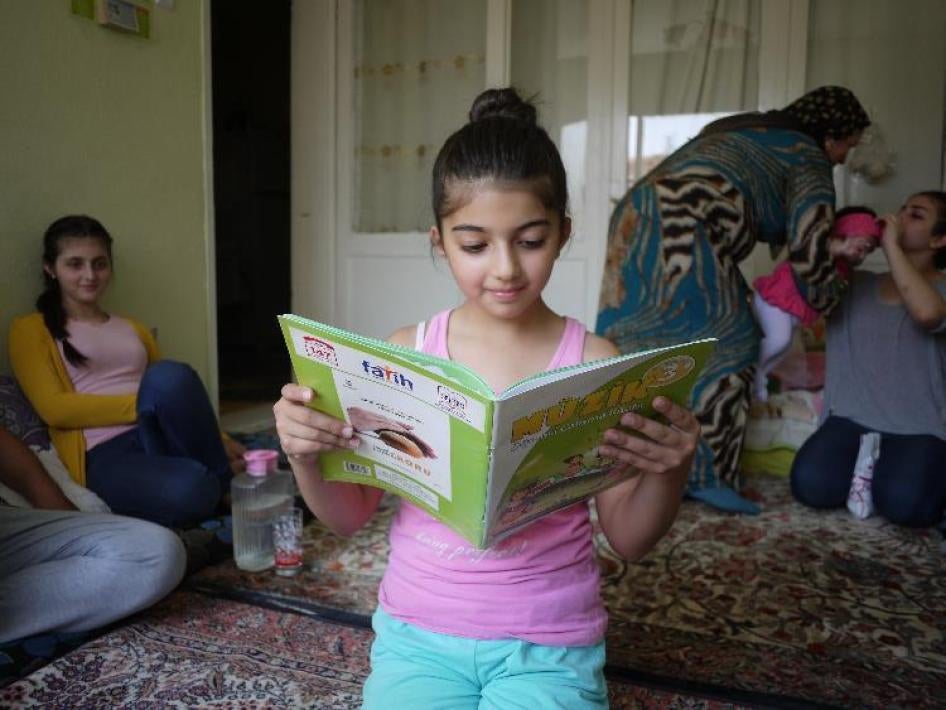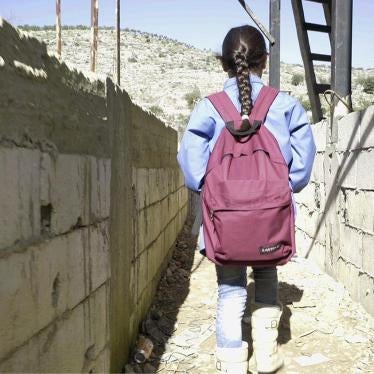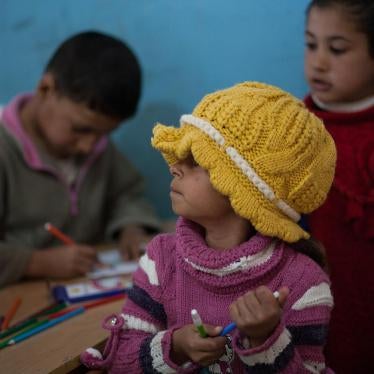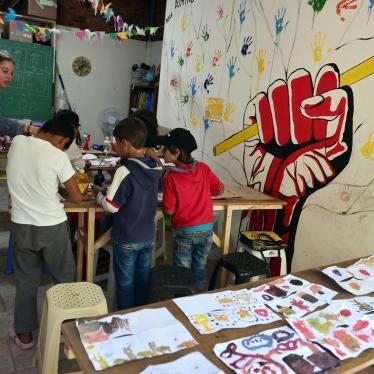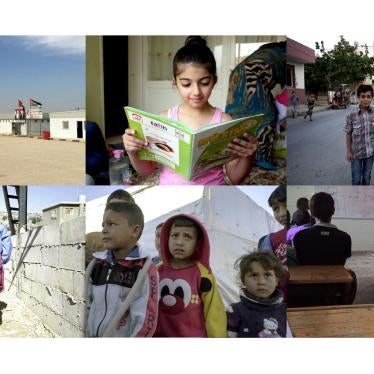Education for Syrian children has become a casualty of war: school enrollment rates have fallen drastically, not only in Syria but among children who have fled. Turkey, Lebanon, and Jordan have taken generous steps to provide Syrian children with access to education, yet more than half of the 1.5 million school-age refugee children in those three countries were not in formal education last year.
Syrian refugee families told Human Rights Watch that they fled to protect their children’s lives, but that their children's futures are now at risk. Rates of early marriage and child labor have risen dramatically among Syrian refugee children, and the longer children are out of school, the lower the likelihood they will return and get an education. The lack of educational opportunities is a key reason Syrian refugees want to flee to Europe.[i]
To enable adequate planning for the coming school year and beyond so that refugee children can go to school, donors should fulfill their pledges promptly.
They should also support host countries to revise policies that Human Rights Watch has documented are keeping children out of school.[iv] Policies that require refugees to obtain government-issued documentation or legal status but in effect prevent many from doing so, and that leave many impoverished refugees unable to work lawfully, are undermining the right to education.
Removing obstacles to education is critical for refugee children to recover from conflict, realize their rights, contribute to host countries, and ultimately rebuild Syria. Yet every year since the conflict began, the number of Syrian children out of school has increased. Globally, more than 6.7 million refugees are in exile due to crises that began more than 20 years ago—longer than an entire childhood.[v] President Obama’s Leaders’ Summit on Refugees on September 20 will seek pledges to get a million refugee children in school, but around the world there are more than 3.5 million out-of-school refugee children.[vi] This document, based on extensive Human Rights Watch research in Turkey, Lebanon, and Jordan, lays out steps that donors and host countries should take to ensure that Syria does not suffer a lost generation.
Turkey
Turkey allows Syrian children to enroll free in Turkish public schools, and in addition, the Ministry of National Education has accredited “temporary education centers,” staffed with Syrian teachers, that use a modified Syrian Arabic curriculum. The United Nations Children’s Fund (UNICEF) reported that in 2015, seven new schools were built in Turkey, 200 were renovated, 8,700 Syrian “volunteer” teachers were hired, and more than 10,000 Syrian students received subsidized school transportation, leading to a 30 percent increase in the number of children in school over the previous year.[vii]
Despite these steps, the education minister said in April that only 325,000 of more than 756,000 school-age Syrian refugees are attending formal schools and education centers.[viii] In fact, the number of out-of-school children may be even higher: Turkey’s registration figures show more than 930,000 Syrian children ages 5-17, with a steep decline in enrollment as children grow older.[ix]
Turkish officials intend to enroll all Syrian children in school by the end of 2017 and continue to work toward that goal.[x] It is ambitious, but feasible: the entire school-age Syrian population is only 5 percent of the 16.4 million children enrolled in Turkey’s public schools (based on 2014-2015 figures).[xi] Donors should support Turkey to take the following steps:
- Ensure That Lack of Identification Documents is Not a Barrier to Education
Turkey’s generous enrollment policy does not require Syrian refugee children to prove their residency, but does require them to produce Turkish-issued identification (ID) cards. In 2015, nearly all Syrian refugee families Human Rights Watch interviewed had obtained these cards without undue difficulty or delay. However, after Turkish authorities introduced a new “pre-registration and screening” step in March 2016, Syrian families described a backlog with waiting times of up to six months for these cards.[xii] In some areas, Turkish public school administrators refused to allow Syrian children to enroll even if they had the identification cards, or the school officials demanded other documents. Turkish authorities should:
- Urgently clear the backlog of ID card applications, and in the interim, allow Syrians to provide other documentation in lieu of an ID card to enroll in school.
- Enforce Turkey’s education policies at the local level.
- Address Disincentives to Education and Causes of Dropouts
For most Syrian children who enroll in Turkish public schools, as 75,000 did last year, the language of instruction is foreign and new, and access to accelerated language learning programs is limited. Older children in higher grades, in particular, may be unable to understand lessons in Turkish, and drop out. Many children are unable to afford transportation to schools, while others face harassment and perceived discrimination. Turkey has begun to address some of these barriers, but much more is needed. Donors should support Turkey to:
- Substantially increase access to programs offering Turkish language support and accelerated language learning for Syrian children.
- Increase the number of Syrian “volunteer” teachers who receive stipends for teaching in “temporary education centers” in the short term, while also planning to reach Turkey’s goal of integrating all Syrian students in the Turkish public school system.
- Increase subsidized transportation to schools.
- Reduce Child Labor and Dropouts by Increasing Adults’ Access to Work
Turkey is a leader among host countries for creating a pathway for Syrians to obtain work permits. In practice, however, the number of work permits made available would accommodate fewer than 1 percent of Syrian refugees, since employers must sponsor them and promise to pay a minimum wage.[xiii] Syrian children often need to supplement their family’s income by dropping out of school to work, and are paid even less than Syrian adults.[xiv] Improving Syrian workers’ access to labor protections could mitigate the high rate of child labor, including hazardous work, among Syrian refugee households.
- Turkey should amend regulations to allow refugees to apply for work permits directly, rather than requiring employer sponsorship.
- Donors, working with Turkish authorities, should consider expanding support for livelihoods and income-creation programs, to reduce pressure on Syrian children to drop out of school to work.
Lebanon
Lebanon, a country of approximately 4.5 million citizens, has 1 million registered Syrian asylum seekers, including almost 500,000 school-age children—more than the number of Lebanese children in public schools. With donor support, Lebanese authorities last year offered 200,000 places for Syrian children to enroll free in public schools, and opened afternoon “second shift” classes in 238 public schools to increase classroom spaces. But only 158,000 Syrian children enrolled in public schools, while another 87,000 attended private and semi-private schools. At least 250,000 Syrian children were not in formal education, including at least 95 percent of secondary school-age children.[xv] Lebanon has set a target of enrolling an additional 230,000 “non-Lebanese” children in formal education and 220,000 in an non-formal education programs during the 2016-17 school year. Donors should support Lebanon in taking these steps to ensure Syrian children’s access to education:
- Waive Residency Requirements to Reduce Child Labor and Dropouts
Lebanon imposed new residency requirements on Syrian refugees in January 2015, obliging all of those age 15 and older to pay annual residency renewal fees of $200 per person and – for those not registered with the United Nations refugee agency – sponsorship by a Lebanese sponsor to legally stay in the country. An estimated two-thirds of Syrian refugees have been unable to renew their legal status, with severe implications for access to education.
Lebanon’s generous, donor-supported refugee education policy does not require Syrian children to have residency to enroll. But some school directors have required them to provide it, as well as a variety of other documents that are not officially required and that many Syrians are unable to produce.
The residency requirements are also exacerbating refugees’ poverty, because refugees without valid residency are at risk of arrest, which limits their ability to travel in search of informal work. In 2015, 70 percent of Syrian households lived below the Lebanese poverty line of $3.84 per person per day and 89 percent were in debt. Impoverished refugees often cannot pay for transportation to school or depend on child labor to pay for basic needs, and working children often drop out of school and are at risk of exploitation, arrest, violence, and hazardous work. Parents without residency are also afraid to enroll their children if their school is located beyond a checkpoint.
- The Interior Ministry and General Security Organization should waive the residency fee and sponsorship requirements for refugees and urgently ensure their freedom of movement.
- In the interim, Lebanese ministries should ensure that children age 15 and older who are directly affected by lack of residency are able to travel to and enroll in schools.
- Donors should urgently increase funding to support Syrians’ livelihoods, including income-generating work, and to help offset refugees’ school-related transportation costs.
- The Ministry of Education should ensure that all school administrations implement the official enrollment policy and that refugees can report irregularities, and hold accountable those who violate the policy.
- Address Disincentives to Education and Causes of Dropouts
Beginning in grade 7, Lebanese public schools teach most morning shift classes entirely in English or French—unfamiliar languages for many Syrian children. In afternoon shifts at primary schools, most classes are supposed to be taught in Arabic, but science and math classes are also taught in English or French, and in practice some teachers are teaching all classes in those languages. There are no Arabic language shifts at the secondary school level. Families also report inattentive teachers and a lack of textbooks in some schools.
Syrian families also describe widespread corporal punishment of children, as young as 5, by teachers, school administrators, and bus drivers. Children face bullying, discrimination, and harassment on the way to school and in the classroom, without sufficient intervention from teachers and school administrators. In some cases, teachers have not allowed Syrian children to use bathroom facilities at school. As a result, students have dropped out or parents have withdrawn their children.
- The Education Ministry, with donor support, should provide language support programs, particularly for intermediate- and secondary-school-age children.
- The ministry should enforce its ban on corporal punishment in public schools, hold teachers accountable, and strengthen protection mechanisms to ensure that allegations of corporal punishment, harassment, or discrimination are promptly investigated and redressed.
- The ministry, with donor support, should improve teacher training, and increase the utilization of qualified Syrian teachers.
- Clarify the Role of Nongovernmental Groups in Non-Formal Education
When Lebanese public schools are full or far away, Syrian children often depend on non-formal education. However, these programs are of widely varying quality, and many do not offer a pathway to formal education. In 2015, the Education Ministry withdrew support for programs operated by nongovernmental groups, including by requesting that certain non-formal schools shut down and asking public school directors to report on any such schools nearby. The ministry has now established a framework for non-formal education in 2016-17, but the role that nongovernmental groups will be allowed to play in reaching out of school children remains unclear.
- Until all children can enroll in formal education, the Lebanese government should urgently clarify the role of nongovernmental groups as partners in providing education and carry out the 2016 non-formal education framework.
Jordan
About 80,000 of the 225,000 school-aged Syrian children in Jordan were out of school last year. With the “Jordan Compact” between Jordan and donors in February, donors pledged $700 million per year over three years to support Jordan in hosting Syrian refugees, and in May, donors pledged an additional $81.5 million to improve access to education.[xvi] Under the compact, Jordan aims by fall 2016 to enroll an additional 50,000 Syrian children in formal education and up to 25,000 children ages 8 to 12 in an accredited, accelerated program that will enable them to attend public schools upon completion. Increased funding that enables Jordan to carry out these plans could substantially improve access to education. Donors should fulfil their funding pledges promptly, and work with Jordan to continue to expand reforms to address other barriers:
- Ensure that Lack of Documentation is Not a Barrier to Education
Jordan requires the roughly 520,000 refugees who live outside refugee camps to register with the Interior Ministry and obtain “service cards.” These cards are officially required for Syrian refugees to access subsidized healthcare and to enroll children in schools, and are only valid in the district where they are registered.[xvii] Thousands of Syrian refugees, including nearly all of those who left refugee camps after regulations changed in July 2014, as well as the estimated 30 to 40 percent of Syrian children in Jordan who lack birth certificates, are currently ineligible for service cards. In addition, since February 2015, Jordan has required all Syrians in host communities to obtain new service cards, but imposed difficult requirements; about 200,000 Syrians had not done so as of early April 2016. In a positive move, Jordan’s Education Ministry has instructed public schools to allow Syrian children without service cards to enroll in the fall 2016 semester, during which they should obtain the cards.[xviii] If they cannot do so, it is not clear if they will be allowed to re-enroll in the spring semester.
- Jordan should continue to demonstrate flexibility and ensure that schools will not refuse to enroll Syrian children who are unable to obtain service cards or birth certificates and will allow them to present other forms of identification.
- Continue to Increase Access to Work Permits and End Disproportionate Penalties
About 86 percent of Syrian refugees live below Jordan’s poverty line of 68 Jordanian dinars ($95) per person per month. A UN assessment found in 2015 that 97 percent of school-age Syrian children are at risk of not going to school because of financial hardship. Until recently, it was virtually impossible for Syrian refugees to obtain work permits, but Jordan imposed penalties on those caught working without permits including arrest, fines, involuntary relocation to refugee camps, and in some reported cases, deportation.[xix] Syrian children are at risk of dropping out of school to work in cases where the breadwinner has been arrested.
Jordan has taken a series of positive steps to improve access to work permits. In February 2016, Jordan pledged to issue permits to up to 200,000 Syrians, but these plans are contingent on factors including increased foreign private investment and exports to European markets.[xx] In April, Jordan granted a three-month grace period for Syrians to obtain work permits without paying fees, then extended it for an equal period, issuing more than 20,000 permits while limiting arrests and transfers to refugee camps of Syrians who worked informally.[xxi] However, most Syrians still lack permits because the requirements include the sponsorship of an employer, who may be unwilling to sign contracts and pay the minimum wage, while Syrians who lack service cards are ineligible to apply for work permits.
- Jordan should continue to expand Syrians’ access to labor protections and the formal labor market.
- Donors should deliver promptly on pledges intended to improve Syrians’ access to work and set clear targets for Syrian employment.
- Jordan should permanently waive policies that disproportionately punish Syrians caught working without permits and investigate alleged unlawful deportations.
- Address Causes of Dropouts and Improve Access to Non-Formal and Secondary Education
Corporal punishment in schools and bullying by other children cause hundreds of Syrian children to drop out each year.[xxii] Human Rights Watch interviewed Syrian parents who said their children were not learning in school, and Jordanian teachers who had no training and faced classrooms of up to 50 students.
Jordanian regulations that pre-existed the Syria conflict bar all children who have been out of school for three or more years from enrolling in public schools. With donor support, in the fall of 2016 Jordan plans to establish an accredited non-formal curriculum for up to 25,000 Syrian children ages 8 to 12 who would otherwise have been barred by the “three-year rule;” for children ages 13 and older, the Education Ministry has accredited a nongovernmental group to provide non-formal education. While donors are supporting the group to expand its program, access remains limited, and it has reached only a few thousand Syrian children since the Syria conflict began.
Older children need much more support to get an education, as many face increased pressure to work or are vulnerable to early marriage, and have spent years out of school. Fewer than 5,400 out of at least 25,000 Syrian 16- and 17-year-olds in Jordan were in secondary school last year. Children and youth have had little access to technical and vocational education and training, and demand is low because nearly all available jobs are unskilled.
- The Education Ministry should enforce the prohibition against corporal punishment in schools.
- With donor support, Jordan should improve teacher training, and utilize the skills of qualified Syrian teachers.
- Jordan and foreign donors should expand the provision of non-formal education for children older than 13, and significantly increase Syrian children’s access to secondary education and vocational training.
[i] Melissa Fleming (United Nations High Commissioner for Refugees (UNHCR)), “Six reasons why Syrians are fleeing to Europe in increasing numbers,” The Guardian, October 25, 2015, https://www.theguardian.com/global-development-professionals-network/2015/oct/25/six-reasons-why-syrians-are-fleeing-to-europe-in-increasing-numbers (accessed September 2, 2016).
[ii] “Co-hosts declaration from the Supporting Syria & the Region Conference, London 2016,” February 4, 2016, https://www.supportingsyria2016.com/news/co-hosts-declaration-of-the-supporting-syria-and-the-region-conference-london-2016/ (accessed September 2, 2016).
[iii] Kevin Watkins (Theirworld), “No lost generation – holding to the promise of education for all Syrian refugees,” , August 2, 2016, http://youthstories.aworldatschool.org/the-promise#chapter-1296657 (accessed September 2, 2016).
[iv] “Education for Syrian Refugee Children,” Human Rights Watch, https://www.hrw.org/tag/education-syrian-refugee-children.
[v] UNHCR, “Global Trends: Forced Displacement in 2015,” June 20, 2016, , http://www.unhcr.org/576408cd7.pdf (accessed September 2, 2016), p. 20.
[vi] The White House, Office of the Press Secretary, “Statement by National Security Advisor Susan Rice on Co-Hosts for President Obama’s Leaders’ Summit on Refugees,” June 3, 2016, White House press release, https://www.whitehouse.gov/the-press-office/2016/06/03/statement-national-security-advisor-susan-rice-co-hosts-president-obamas (accessed September 8, 2016); Save the Children, “Half of All Refugee Children Are Out of School Leaving Them Exposed to Exploitation and Abuse,” May 16, 2016, http://www.savethechildren.org/site/apps/nlnet/content2.aspx?c=8rKLIXMGIpI4E&b=9357115&ct=14850115¬oc=1 (accessed September 2, 2016).
[vii] United Nations Children’s Fund (UNICEF), “Turkey Monthly Update – December,” Regional Refugee & Resilience Plan 2015-2016 (]), http://data.unhcr.org/syrianrefugees/download.php?id=10191 (accessed September 2, 2016).
[viii] “Syrian refugee children remain unschooled despite efforts,” Daily Sabah, April 27, 2016, http://www.dailysabah.com/nation/2016/04/28/syrian-refugee-children-remain-unschooled-despite-efforts (accessed September 2, 2016).
[ix] United Nations High Commissioner for Refugees (UNHCR), “Turkey,” Syria Regional Refugee Response website, undated, , http://data.unhcr.org/syrianrefugees/country.php?id=224 (accessed September 2, 2016).
[x] “Only 30 percent of Turkey’s Syrian children have access to education: Disaster agency head,” Hurriyet Daily News, March 31, 2016, http://www.hurriyetdailynews.com/only-30-pct-of-turkeys-syrian-children-have-access-to-education-disaster-agency-head.aspx?PageID=238&NID=97133&NewsCatID=341 (accessed September 8, 2016); “New road map to boost education for Syrian refugees,” Daily Sabah, August 23, 2016, http://www.dailysabah.com/education/2016/08/24/new-road-map-to-boost-for-syrian-refugees-education (accessed September 2, 2016).
[xi] “When I Picture My Future, I See Nothing” Barriers to Education for Syrian Refugee Children in Turkey, Human Rights Watch, November 2015, https://www.hrw.org/report/2015/11/08/when-i-picture-my-future-i-see-nothing/barriers-education-syrian-refugee-children.
[xii] “EU: Don’t Send Syrians Back to Turkey,” Human Rights Watch news release, June 20, 2016, https://www.hrw.org/news/2016/06/20/eu-dont-send-syrians-back-turkey.
[xiii] Patrick Kingsley, “Fewer than 0.1% of Syrians in Turkey in line for work permits,” The Guardian, April 11, 2016, https://www.theguardian.com/world/2016/apr/11/fewer-than-01-of-syrians-in-turkey-in-line-for-work-permits (accessed September 2, 2016).
[xiv] Stephanie K. Gee (Human Rights Watch), “When Refugees Work, Children More Likely to Attend School,” August 8, 2016, commentary, Refugees Deeply, https://www.hrw.org/news/2016/08/08/when-refugees-work-children-more-likely-attend-school.
[xv] “Growing Up Without an Education” Barriers to Education for Syrian Refugee Children in Lebanon, Human Rights Watch, June 2016, https://www.hrw.org/report/2016/07/19/growing-without-education/barriers-education-syrian-refugee-children-lebanon.
[xvi] UNICEF, “Five international donors grant JOD 57.7 million to GOJ commitment to reach education to all children in Jordan,” May 26, 2016, http://www.unicef.org/jordan/media_11026.htm (accessed September 2, 2016).
[xvii] “We’re Afraid for Their Future” Barriers to Education for Syrian Refugee Children in Jordan, Human Rights Watch report, August 16, 2016, https://www.hrw.org/report/2016/08/16/were-afraid-their-future/barriers-education-syrian-refugee-children-jordan.
[xviii] “Jordan: Positive Steps on Education for Syrian Children,” Human Rights Watch news release, August 22, 2016, https://www.hrw.org/news/2016/08/22/jordan-positive-steps-education-syrian-children.
[xix] “We’re Afraid for Their Future.”
[xx] “The Jordan Compact: A New Holistic Approach between the Hashemite Kingdom of Jordan and the International Community to deal with the Syrian Refugee Crisis,” February 4, 2016, https://2c8kkt1ykog81j8k9p47oglb-wpengine.netdna-ssl.com/wp-content/uploads/2016/02/Supporting-Syria-the-Region-London-2016-Jordan-Statement.pdf (accessed September 2, 2016), p. 2.
[xxi] UNHCR, “Frequently Asked Questions: Work Permits for Syrian Refugees in the Urban Environment in Jordan,” April 14, 2016, http://reliefweb.int/report/jordan/frequently-asked-questions-work-permits-syrian-refugees-urban-environment-jordan-enar (accessed September 8, 2016); “Jordan extends waiver period for Syrian refugee work permits,” Associated Press, July 11, 2016).
[xxii] UNICEF estimates that bullying by children causes 1,600 Syrian children to drop out of school each year. Matteo Valenza and Shatha AlFayez (UNICEF), “Running on Empty: The situation of Syrian children in host communities in Jordan,” May 2016, http://www.unicef.org/jordan/Running_on_Empty2.pdf (accessed August 2, 2016).
